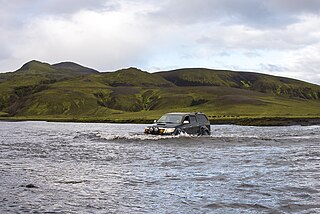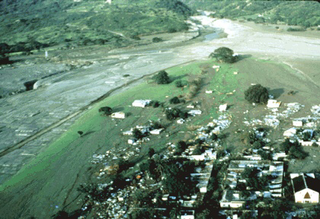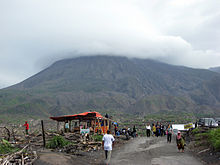
A volcano is a rupture in the crust of a planetary-mass object, such as Earth, that allows hot lava, volcanic ash, and gases to escape from a magma chamber below the surface.

Mount Vesuvius is a somma-stratovolcano located on the Gulf of Naples in Campania, Italy, about 9 km (5.6 mi) east of Naples and a short distance from the shore. It is one of several volcanoes forming the Campanian volcanic arc. Vesuvius consists of a large cone partially encircled by the steep rim of a summit caldera, resulting from the collapse of an earlier, much higher structure.
Tourism in Puerto Rico attracts millions of visitors each year, with more than 5.1 million passengers arriving at the Luis Muñoz Marín International Airport in 2022, the main point of arrival into the island of Puerto Rico. With a $8.9 billion revenue in 2022, tourism has been a very important source of revenue for Puerto Rico for a number of decades given its favorable warm climate, beach destinations and its diversity of natural wonders, cultural and historical sites, festivals, concerts and sporting events. As Puerto Rico is an unincorporated territory of the United States, U.S. citizens do not need a passport to enter Puerto Rico, and the ease of travel attracts many tourists from the mainland U.S. each year.

Mayon, also known as Mount Mayon and Mayon Volcano, is an active stratovolcano in the province of Albay in Bicol, Philippines. A popular tourist spot, it is renowned for its "perfect cone" because of its symmetric conical shape, and is regarded as sacred in Philippine mythology.

Eyjafjallajökull, sometimes referred to by the numeronym E15, is one of the smaller ice caps of Iceland, north of Skógar and west of Mýrdalsjökull. The ice cap covers the caldera of a volcano with a summit elevation of 1,651 metres (5,417 ft). The volcano has erupted relatively frequently since the Last Glacial Period, most recently in 2010, when, although relatively small for a volcanic eruption, it caused enormous disruption to air travel across northern and western Europe for a week.

The Highland or The Central Highland is an area that comprises much of the interior land of Iceland. The Highland is situated above 300–400 meters and is mostly uninhabitable. The soil is primarily volcanic ash, and the terrain consists of basalt mountains and lava fields. Snow covers the Highland from October until the beginning of June. A few oasis-like areas such as Herðubreiðarlindir and Þórsmörk are also found in the Highland. The Highland has many notable natural features and hiking trails.

Pacaya is an active complex volcano in Guatemala, which first erupted approximately 23,000 years ago and has erupted at least 23 times since the Spanish conquest of Guatemala. It rises to an elevation of 2,552 metres (8,373 ft). After being dormant for over 70 years, it began erupting vigorously in 1961 and has been erupting frequently since then. Much of its activity is Strombolian, but occasionally Plinian eruptions also occur, sometimes showering the area of the nearby Departments with ash.

Saint-Pierre is a town and commune of France's Caribbean overseas department of Martinique, founded in 1635 by Pierre Belain d'Esnambuc. Before the total destruction of Saint-Pierre by a volcanic eruption in 1902, it was the most important city of Martinique culturally and economically, being known as "the Paris of the Caribbean". While Fort-de-France was the official administrative capital, Saint-Pierre was the cultural capital of Martinique. After the disaster, Fort-de-France grew in economic importance.

The Armero tragedy occurred following the eruption of the Nevado del Ruiz stratovolcano in Tolima, Colombia, on November 13, 1985. The volcano's eruption after 69 years of dormancy caught nearby towns unprepared, even though volcanological organizations had warned the government to evacuate the area after they detected volcanic activity two months earlier.

Mount Sinabung is a Pleistocene-to-Holocene stratovolcano of andesite and dacite in the Karo plateau of Karo Regency, North Sumatra, Indonesia, 40 kilometres (25 mi) from the Lake Toba supervolcano. Many old lava flows are on its flanks and the last known eruption, before recent times, occurred 1200 years before present, between 740 - 880 CE. Solfataric activities were last observed at the summit in 1912; recent documented events include an eruption in the early hours of 29 August 2010 and eruptions in September and November 2013, January, February and October 2014. The volcano has recently claimed the life of at least 23 people in a number of events since 2014. Between 2013 and 2014, the alert for a major event was increased with no significant activity. On 2 June 2015, the alert was again increased, and on 26 June 2015, at least 10,000 people were evacuated, fearing a major eruption. The long eruption of Mount Sinabung is similar to that of Mount Unzen in Japan, which erupted for five years after lying dormant for 400 years. A major eruption began on 10 August 2020.

Several types of volcanic eruptions—during which material is expelled from a volcanic vent or fissure—have been distinguished by volcanologists. These are often named after famous volcanoes where that type of behavior has been observed. Some volcanoes may exhibit only one characteristic type of eruption during a period of activity, while others may display an entire sequence of types all in one eruptive series.

Slum tourism, poverty tourism, ghetto tourism or trauma tourism is a type of tourism that involves visiting impoverished areas, or in some cases, areas that were affected by disasters, such as nuclear fallout zones like Chernobyl or Fukushima. Originally focused on the slums and ghettos of London and Manhattan in the 19th century, slum tourism is now prominent in South Africa, India, Brazil, Kenya, Philippines and the United States.

Between March and June 2010 a series of volcanic events at Eyjafjallajökull in Iceland caused enormous disruption to air travel across Western Europe.

In late October 2010, Mount Merapi in border of Central Java and Special Region of Yogyakarta, Indonesia began an increasingly violent series of eruptions that continued into November. Seismic activity around the volcano increased from mid-September onwards, culminating in repeated outbursts of lava and volcanic ash. Large eruption columns formed, causing numerous pyroclastic flows down the heavily populated slopes of the volcano. The 2010 eruption of Merapi was the volcano's largest since 1872.

Hurricane Maria was a deadly Category 5 hurricane that devastated the northeastern Caribbean in September 2017, particularly in the U.S. territory of Puerto Rico, which accounted for 2,975 of the 3,059 deaths. It is the deadliest and costliest hurricane to strike the island of Puerto Rico, and is the deadliest hurricane to strike the country of Dominica and the territory of the U.S. Virgin Islands. The most intense tropical cyclone worldwide in 2017, Maria was the thirteenth named storm, eighth consecutive hurricane, fourth major hurricane, second Category 5 hurricane, and deadliest storm of the extremely active 2017 Atlantic hurricane season. Maria was the deadliest Atlantic hurricane since Mitch in 1998, and the tenth most intense Atlantic hurricane on record. Total monetary losses are estimated at upwards of $91.61 billion, mostly in Puerto Rico, ranking it as the fourth-costliest tropical cyclone on record.

On 9 December 2019, Whakaari / White Island, an active stratovolcano island in New Zealand's northeastern Bay of Plenty region, explosively erupted. The island was a popular tourist destination, known for its volcanic activity, and 47 people were on the island at the time. Twenty-two people died, either in the explosion or from injuries sustained, including two whose bodies were never found and were later declared dead. A further 25 people suffered injuries, with the majority needing intensive care for severe burns. Continuing seismic and volcanic activity, together with heavy rainfall, low visibility and the presence of toxic gases, hampered recovery efforts over the week following the incident.

Fagradalsfjall is an active tuya volcano formed in the Last Glacial Period on the Reykjanes Peninsula, around 40 kilometres (25 mi) from Reykjavík, Iceland. Fagradalsfjall is also the name for the wider volcanic system covering an area 5 kilometres (3 mi) wide and 16 kilometres (10 mi) long between the Eldvörp–Svartsengi and Krýsuvík systems. The highest summit in this area is Langhóll. No volcanic eruption had occurred for 815 years on the Reykjanes Peninsula until 19 March 2021 when a fissure vent appeared in Geldingadalir to the south of Fagradalsfjall mountain. The 2021 eruption was effusive and continued emitting fresh lava sporadically until 18 September 2021.
















